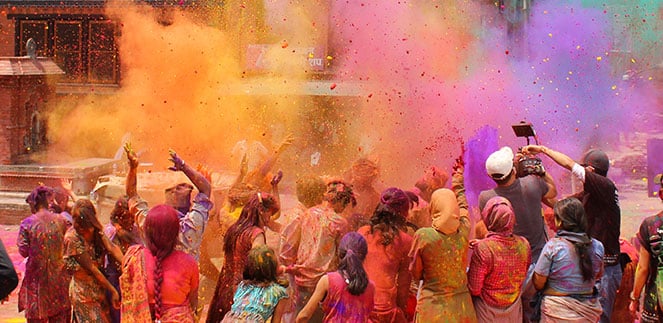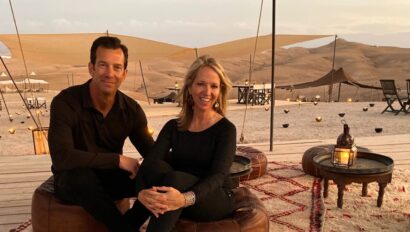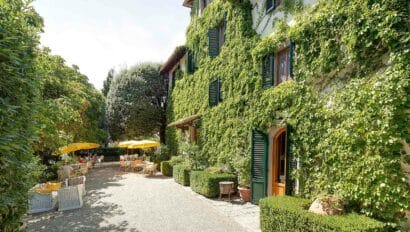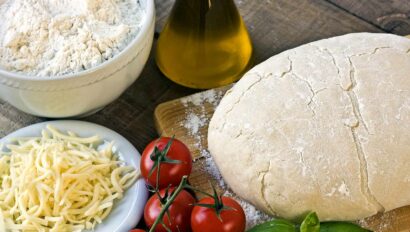There are plenty of reasons to visit India. From the beautiful landscapes to the food to the classic architecture, India is rightly considered a top destination for adventurous travelers. India festivals are an excellent way to experience every facet of India’s vibrant culture. India is a deeply spiritual country, and religious festivals are a central part of the Indian lifestyle. But although most of India’s festivals have a religious significance, they are far from somber affairs. When Indians gather to celebrate, the results can be truly spectacular – the feasts, dancing, music and decorative colors are unlike anything you’re likely to encounter anywhere else.
There are numerous festivals in India held throughout the year. Most Indian festivals have ties to the Hindu religion, and typically celebrate Hindi gods or prominent figures from religious stories. Some festivals feature some fairly unusual and exciting traditions – one highlight of the festival of Krishna Janmashtami is a competition of sorts, in which men form large human pyramids in an attempt to reach and smash clay pots hanging from tall buildings. Certain cities have favorite festivals; in Kolkata, the festival known as Durja Puja is the most popular, with each of its nine days representing one of the nine human forms of the Mother Goddess Durja. But there are two India festivals that truly stand out, and are well worth planning a trip around. Holi Festival and the Pushkar Camel Fair both offer amazing experiences for India visitors. And while there are some similarities, the two are very different and equally enticing.
The Pushkar Camel Fair
If the thought of thousands of camels competing in a sort of camel beauty pageant – decked out in all manner of colorful beads, scarves, and even makeup – sounds intriguing, the Pushkar Camel Fair delivers that and much more. It’s likely the most unusual of India’s festivals, and was actually borne out of a religious observance.
The Pushkar Camel Fair is held in the town of Pushkar, in India’s Rajasthan province – as one might expect, Pushkar is located at the edge of a desert. The fair itself isn’t a religious observance, but it does coincide with one. The Pushkar Lake is a Hindu holy site, and the destination of pilgrims during the Hindu month of Kartik (overlapping November). Originally, camel and livestock traders would bring their herds to Pushkar to do business during the accompanying Kartik Purnima festival. During its historical heyday, tens of thousands of camels would be brought to the small town to be traded – often, the sale of a prized camel was a family’s only chance to earn income for the year. The camel trading event became its own popular affair; while camels are still bought and sold during the Pushkar Fair, the event has evolved into something resembling India’s version of an American state fair. Visitors are treated to familiar carnival rides, vendors sell local street food, and various carnival performers put on a show – one big difference is that American state fairs typically don’t feature snake charmers! You’ll also get a great chance to experience Indian music and dance, courtesy of local artists.
The camels themselves are the main attraction. Although the number of attending camels isn’t what it used to be, you’ll still be among a massive throng of the tall, hump-backed “ships of the desert.”. To showcase their mounts’ abilities, camel owners hold camel races, which are truly exciting – the lanky camels are much faster than they look! But the most unusual aspect of the Pushkar Fair is the beauty contests. Camels are adorned with all sorts of baubles and accessories, and some are even shaved and given hairstyles. There’s nothing quite like seeing a fully dressed-out Pushkar Fair camel. And the riders take part as well, wearing incredibly elaborate costumes and headscarves.
There is a spiritual component to the festivities, and visitors can observe that as well. The Kartik Purnima festival culminates during the month of Kartik’s full moon period. Pilgrims come to bathe in the waters of Pushkar Lake; doing so during the day of the full moon is considered to be the optimal time when pilgrims receive extra blessings. In the evenings, visitors can watch the lovely maha aarti candle ceremony by the lake’s shores; hundreds gather after sunset for this tradition, and the light from hundreds of candles illuminating the lake is unforgettable.
India’s Holi Festival
The Holi Festival may well be the world’s most popular Indian festival, or at least the most recognized. That’s due to the tradition of “playing Holi” – throwing colorful powders and water on fellow revelers. During the festival, which typically occurs in March and can last from two days to a week, color “battles” are the big draw. Descriptions can’t really do it justice; large, jubilant crowds of people cover each other in pink, purple, orange, and just about every color on the spectrum, singing and dancing and generally having the time of their lives. Holi is celebrated all over India and is especially popular in the northern parts of the country. It’s also celebrated in Indian communities around the world; large cities with big Indian populations will usually have their own Holi Festival. For those curious, stopping by a Holi celebration in New York or Los Angeles is a great way to experience it. Surprisingly, the country’s largest Holi Festival is actually in Spanish Fork, Utah, just outside of Provo. With some 70,000 people attending each year, the Utah Holi celebration is likely the one that raised American awareness of this particular festival.
Holi, like other Indian festivals, has its roots in the Hindu religion. Holi is known for being a fun party, but it also celebrates Indian culture and the Hindu religion. While there are several Hindi myths that the Holi Festival incorporates, the throwing of colors has ties to the god Krishna’s reputation as a prankster – he smeared colors onto the face of the goddess Radha while attempting to court her, and also enjoyed throwing colorful flowers and water on unsuspecting cattle herders. That mischievous story sets the tone for the modern Holi Festival.
Reflecting the fun nature of the festival, Holi is also a time for friends and family. Celebrating Holi often includes spending time with loved ones, enjoying meals and sweet treats. It’s not uncommon to be offered bhang, a cannabis-infused paste that’s mixed into desserts or teas. (Bhang does have a slightly intoxicating effect, something to keep in mind if you decide to partake.) Different Indian cities add different elements to the Holi Festival. In the town of Barsana, for example, comedic revenge is acted out – the townswomen play the part of female cattle herders, chasing the men who represent Krishna with sticks and pretending (just pretending!) to hit them, as punishment for covering them with colored powder.
Holi is a truly unique experience – and for unprepared travelers, getting covered from head to toe with colored powder can be a unique laundry challenge. For those who want to join in this unforgettable experience, Holi Festivals veterans recommend wearing long-sleeved shirts and long pants that you won’t mind throwing away – as you might expect, those colors don’t come out easily. And it’s probably a good idea to either leave the camera behind or make sure that it’s encased in a protective housing.
Festival Travel Tips
Weather is often a deciding factor when planning a trip to India; temperatures can be hot, and the country experiences monsoons, which can deliver a lot of rain. The Holi Festival is held during the Hindu month of Phalguna, which corresponds to February through March. While Holi is celebrated all over the country, there are areas where the weather makes for a great experience. In Deogarh, for example, Holi occurs during the comfortably warm and dry spring period, with daytime temperatures hovering in the mid-80s. The Pushkar Camel Fair is also undoubtedly popular because of the time of year in which it’s held. November in Pushkar is one of the driest months of the year, and the daytime temperatures are visitor-friendly, averaging in the mid-80s during the day and the 50s at night – similar to India’s springtime weather, and very similar to the American southwest in the fall.
Festivals in India are boisterous and exciting, and can be a challenge to navigate if you’re unfamiliar with either the festivals or the country itself. It’s a good idea to consider group travel if you’re thinking about attending any of the festivals in India. An experienced guide can help you with transportation and lodging, both of which can be hard to find during the India festival season; having a local guide can also be a great benefit when you’re trying to figure out what to see and even what to eat.




